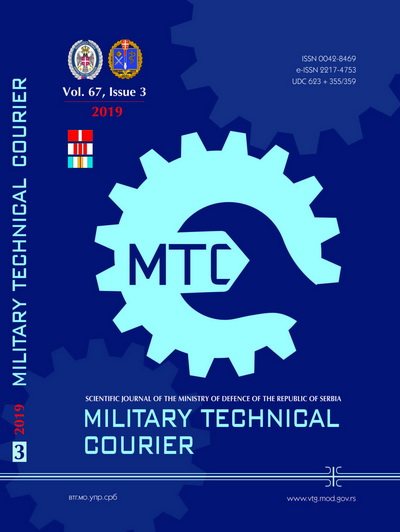Mechanical properties and metallographic analysis of plasma spray APS - Ni5.5wt.%Al5wt.%Mo coatings
Abstract
This paper presents the testing of the mechanical and microstructural characteristics of atmospheric plasma spray (APS) coatings of Ni5.5wt.%Al5wt.%Mo composite powder. The aim of this study was to optimize powder feed (g/min) in order to deposit NiAlMo coating layers with optimum mechanical and structural characteristics to worn aviation parts made of Ni alloy exposed to a combination of corrosion and wear. The microhardness of the deposited layers was tested using HV0.3 and tensile bond strength was tested by tensile testing. The morphology of powder particles was examined on a SEM (scanning electron microscope). The NiAlMo coating microstructure was examined on an optical microscope (OM). Fracture morphology of the top layer was tested on an electronic scanning microscope (SEM). It was found that the control of powder feed can result in coatings with good bond strength.
References
Chen, J., Zhou, H., Zhao, X., Chen, J., An, Y., & Yan, F. 2015. Erratum to: Microstructural Characterization and Tribological Behavior of HVOF Sprayed NiMoAl Coating from 20 to 800 °C. Journal of Thermal Spray Technology, 24(3), pp.281-281. Available at: https://doi.org/10.1007/s11666-014-0193-z.
Conley, J., Fine, M., & Weertman, J. 1989. Effect of lattice disregistry variation on the late stage phase transformation behavior of precipitates in Ni-Al-Mo alloys. Acta Metallurgica, 37(4), pp.1251-1263. Available at: https://doi.org/10.1016/0001-6160(89)90119-3.
Ishak, M., & Takagi, H. 2012. The characteristics of unidirectional solidified Ni-Al-Mo alloys. Materialwissenschaft und Werkstofftechnik, 43(5), pp.416-420. Available at: https://doi.org/10.1002/mawe.201200975.
Lin, B., Huang, M., Zhao, L., Roy, A., Silberschmidt, V., Barnard, N., Whittaker, M., & McColvin, G. 2018. 3D DDD modelling of dislocation–precipitate interaction in a nickel-based single crystal superalloy under cyclic deformation. Philosophical Magazine, 98(17), pp.1550-1575. Available at: https://doi.org/10.1080/14786435.2018.1447159.
Miracle, D.B., Lark, K.A., Srinivasan, V., & Lipsitt, H.A. 1984. Nickel-aluminum-molybdenum phase equilibria. Metallurgical Transactions A, 15(3), pp.481-486. Available at: https://doi.org/10.1007/bf02644971.
Mrdak, M. 2016. Plazma sprej procesi i svojstva zaštitnih prevlaka.Beograd: IHIS Techno experts d.o.o. (in Serbian).
Mrdak, M. 2018. Transfer of heat and speed of plasma particles to powder particles in the plasma spray process at atmospheric pressure. Vojnotehnički glasnik/Military Technical Courier, 66(2), pp.415-430. Available at: https://doi.org/10.5937/vojtehg66-12942.
-Oerlikon Metco. 2017. Material Product Data Sheet, Nickel – Aluminum – Molybdenum Thermal Spray Powders. DSMTS-0111.0. [online] Available at: file:///C:/Users/Intel/Downloads/DSMTS-0111.5_NiAlMo_Powders.pdf. Accessed: 10.05.2018.
-Pratt & Whitney. 2002. Turbojet Engine. Standard Practices Manual.East Hartford,USA: Pratt & Whitney. (PN 582005).
Rico, A., Rodríguez, J., & Otero, E. 2010. High Temperature Oxidation Behaviour of Nanostructured Alumina–Titania APS Coatings. Oxidation of Metals, 73(5-6), pp.531-550. Available at: https://doi.org/10.1007/s11085-010-9191-9.
Proposed Creative Commons Copyright Notices
Proposed Policy for Military Technical Courier (Journals That Offer Open Access)
Authors who publish with this journal agree to the following terms:
Authors retain copyright and grant the journal right of first publication with the work simultaneously licensed under a Creative Commons Attribution License that allows others to share the work with an acknowledgement of the work's authorship and initial publication in this journal.
- Authors are able to enter into separate, additional contractual arrangements for the non-exclusive distribution of the journal's published version of the work (e.g., post it to an institutional repository or publish it in a book), with an acknowledgement of its initial publication in this journal.
- Authors are permitted and encouraged to post their work online (e.g., in institutional repositories or on their website) prior to and during the submission process, as it can lead to productive exchanges, as well as earlier and greater citation of published work (See The Effect of Open Access).

